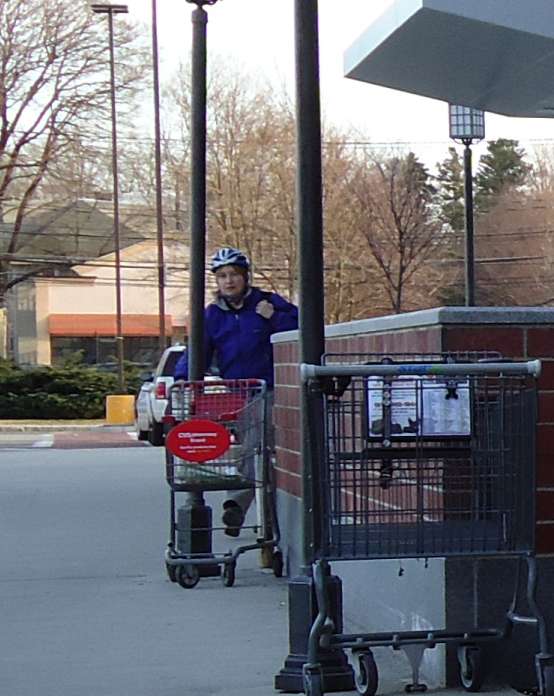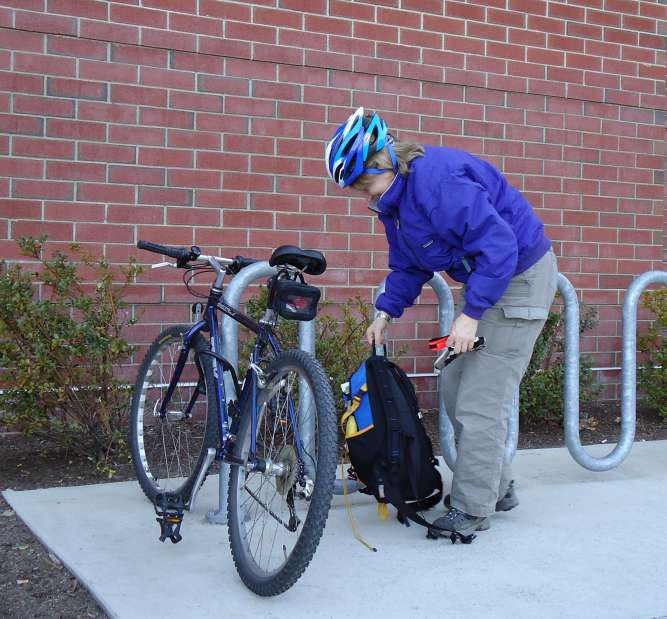Locking and unlocking a bike is an automatic part of a bike traveler’s life. Every cyclist devises a strategy for preventing theft. And, various permutations of locking schemes exist.
Minimalists use a cable wound carelessly through the frame and wrapped around a fixed object, not always one wholly resistant to a mighty tug. Heavy duty bike-lockers lug massive chains and U-locks, often in combination. Most cyclists fall somewhere in-between. They select a lock, usually a cable or U-lock, and may supplement it with another locking device to secure components.
The difference between theft and retention is a matter of time. It isn’t so much the idea of imperviousness as a game of odds. Slowing down a thief buys a greater chance that passing eyes will prove a deterrent to the act.
To implement the bike locking and unlocking strategy a routine must be formulated. Each lock is tested. It is tried in different spots on the frame and wheels. Should a cable be wound? Should it be threaded between frame and wheels? What about the saddle: should it be secured or should convenience be placed before chance?
Practice can be done at home or on the road – preferably the former. It’s best not to draw attention when locking a bike out in the open. A cyclist should always look confident and accomplished to create the impression of knowing how to secure a bike.
Locking must be coordinated with the use of the bike. For commuting, the bike must be outfitted to carry a laptop, files, books, a change of clothes or anything else necessary for work or school. Panniers or trunks for hauling belongings must be easy to secure or remove.
For transportation, a means of carrying purchases is part of the plan. An outfitted rack works for some, a backpack or messenger bag for others. Whichever is chosen, a system of packing and unpacking must be rehearsed.
Once the locking and packing techniques are committed to memory, the cyclist reenacts them time and again…
Outside a store, a forlorn bike tilts toward the heavy metal post preventing it from hitting the ground. An errand-running cyclist with an empty backpack carelessly thrown over her shoulders had locked it there.
Earlier, she had ridden with a destination in mind. Groceries were on her to-do list. As she rode along, she thought about what she needed, hoping that the invigorating ride wouldn’t make her too hungry. Food stores were best avoided with hunger gnawing at one’s stomach.
At the store, her bike hopped up onto the sidewalk. There was no curb cut near the bike rack and she wasn’t in the mood to stop short and walk. Slowing, she dismounted in front of the rack. One foot hit the ground as she swung the other over the saddle.
As she’d done so many times before, she half-slid and half-lifted her bike across the curving metal U’s. She was never sure exactly where to place her bike for safety, but the end of the rack seemed a good choice.
She pulled her U-lock out of its bracket. Opening it, she held the two pieces, one in each hand. Having slipped the lock around the frame and front wheel, she connected the bar to the U in one fell swoop. With a yank on the lock, the bike seemed secure enough.
Sure, someone might remove the rear wheel or notice the quick-release seat post, reeking of vulnerability. But, they’d have to do it in front of customers walking in and out of a busy store. She was willing to take the risk.
With her backpack slung over one shoulder, she sauntered into the store. Her trip wouldn’t take too long so she wore her helmet into the store.
At the checkout, she preferred to pack her food directly into her backpack, even though the store’s employees couldn’t understand why. Paper or plastic were the only options, forcing her to explain the motive for doing it her way.
Items purchased, she strolled out of the store to make the journey home. No engine to start, no trunk to pack, no backing into a parking lot aisle worrying about being blindsided – she could enjoy the day.
Bending down beside her bike, she placed her backpack on the ground to commence the unlocking ritual. She rearranged the items in her backpack to make for easier riding. They had to be balanced, with as little jabbing into her back as possible.
Having watched from afar, I approached and distracted her with conversation – causing her to forget a banana on the ground.
As she spoke, she wriggled into padded backpack straps. The second arm was always a struggle when a backpack was filled to the bursting point.
A neon band was unconsciously wrapped around her right ankle. It would keep her pant leg away from the gritty chain and attract motorists’ eyes.
A key was mechanically extracted from a jacket pocket. She fumbled with the U-lock, maneuvering it at an angle where the key would slide into the keyhole and spin freely. Her technique might have been more graceful, were she not distracted by my questions. As a fellow cyclist, I wanted to know how her luck had been with locking a bike in the area.
“The immediate area has been OK,” she said, effortlessly continuing to make her locked bike ridable. But a friend of hers had had several bikes stolen in Porter Square. I made a mental note not to lock my bike in that vicinity. She pointed out her shoddy bike, which may have improved her luck over her friend’s.
I mentioned having just purchased a bike, still shiny and showroom new. “You should put some dirt on it as a disguise,” she joked. I seriously considered it anyway.
We chatted about bikes for a few minutes as she methodically removed the lock from the bike, lifting it out in front of her to reassemble it before returning it to the worn bracket on her seat tube. Just before mounting the bike, she noticed the banana on the ground and shoved it into a side pocket on her pack.
She mounted her bike and rode down the driveway onto the main road. I watched her pedal away and wondered how many times she’d gone through that ritual before.







